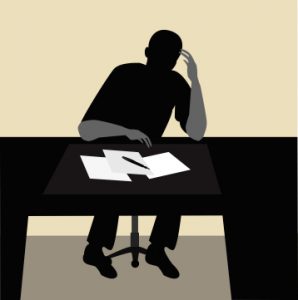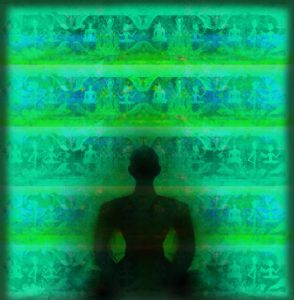Human beings worry everyday. They worry about global politics, national concerns, sports, domestic concerns at home, finances, family, health, weather, relationships, or the most simplistic interactions. Some worries are deeper and more critical to survival while others are very trivial in nature but if we let worries dominate life, then they can cause unneeded damage to the body.
The Serenity Prayer teaches one to let go and to control what can be controlled and to release what cannot be controlled. In understanding this basic ideal, one can releases oneself from the conscious reality of worry and focuses instead on productive reactions to legitimate concerns. Worry itself is the direct mental process of dealing with problems. It is essential because without it, important aspects of life would go untended to. Hence worry is a thinking process that is essential to life but like any function, it is when it misused or overused that issues arise.

Anxiety, an emotional response to worry, can cause immense physiological damage to the body. Anxiety is a dread of what may or may not happen. It is unfounded and based on numerous misconceptions or unreal expectations. 85 percent of bad things the mind can conjure, usually never happen. This worry that leads to unnatural state of anxiety is something that negatively affects the sympathetic nervous system. In addition to anxiety, the worries that surround one become stressors. Stress itself is a physical response to something and again activates the sympathetic nervous system, which in turn, activates such hormones as adrenaline that increases blood pressure and heart rate, as well as tightening muscles and closing down the digestive system to more fight or flight responses. These responses are good if truly in physical danger, but the mental stressors and worries of life usually do not require such an extreme reaction. If in a constant state of anxiety and stress, the body will begin to hurt itself through these responses.
This is why it is so important to worry over what truly matters most and when worrying, to worry well. Worrying over things that cannot be changed do not help to the situation. Worrying late at night, losing sleep, and becoming ill, do not help situations either, but individuals due to a variety of bad worrying habits, or mental ticks are unable to turn off bad worrying. In effect, they become sick from worrying. They do not possess the ability to shut down the sympathetic nervous system to find relaxation.
The Parasympathetic nervous system is the opposite of the Sympathetic. It lowers the heartrate, blood pressure, and relaxes the body’s muscles and permits better digestion. It is imperative to return to this type of operation and find new balance. Individuals with panic and anxiety disorders that explode with worry do not have the abilities to find that balance. Many times they turn to a variety of medications which only blanket the symptoms but once untaken, do nothing for the body to learn to balance
This is why it is so important to learn to worry well. In the MED300/SM550 course, the text and CD of Dr. Weil is utilized to teach individuals how to use meditation and visualization as a way to combat and cope with worry. Dr. Weil emphasizes that one needs to place worries in three different columns. Situations that can be changed, may be changed, and cannot be changed.
Worry should be proportionately applied to things that can be changed. Through identification of what one wishes to accomplish, one can then follow a plan of action, choosing the best options and how those options will be carried out. Affirmation of success is key as a follow through. Dr Weil encourages visualization as a technique in meditation to find a quiet and peaceful place where one can find an inner wisdom guide, which in actuality is one’s unbiased subconscious. Some individuals make this spiritual by prayer and speak with Christ or Mohammed or Buddha, while others relate to deceased parents. This inner wisdom can sometimes supply fresh insight into an issue that seemed difficult prior.
In reaching these states of meditation, Dr Weil believes in the importance of breathing as a source of helping the body again find balance with the Parasympathetic system. Focused, deep, longer breaths can help the body find balance and reduce the tension in the body. The focus on breath also can closely follow Dr. Benson’s Relaxation Response, which follows the same ideals of breath, focus words and muscle relaxation. While these steps follow religious guidelines, they also coincidentally open the body up to more tranquil states associated with the Parasympathetic system. This can reduce the effects of stress, anxiety and unneeded worry.

Good breath work and meditation can be used to free the body from unchangeable worries and also be used to guide the mind to find resolutions for things that can be changed. It can also help the mind find ways to transform oneself to things that cannot be changed. Some worries cannot be altered but they can be accepted and the situation can be adjusted to. The worries that cannot find solutions should generate transformation. In doing so, worrying is then used the natural way it was intended through evolution as a way to help the body deal with problems.
Through analyzation of worry, proper breath work, meditation, visualization and affirmation, one is better equipped to free the body from the stress and anxiety of the Sympathetic Nervous System and allow it to rest but also to be better able to dismiss unneeded worry and focus on real solutions to real life issues.
If you worry too much, it may be time to try to utilize these techniques to minimize unnecessary problems and focus on real problems but in a productive way by retraining how you approach worrying itself.
Please also review AIHCP’s Meditation Instructor Program as well AIHCP’s Stress Management Certification Program and see if they match your academic and professional goals. The programs are online and independent study and open to qualified professionals seeking a four certification.
